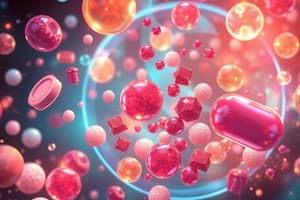Podcast
Questions and Answers
Match the drug classification method with its description:
Match the drug classification method with its description:
Chemical structure classification = Categorizing drugs based on their molecular composition Therapeutic effects classification = Grouping drugs based on the specific benefits they provide Mechanism of action classification = Classifying drugs according to how they work in the body Drug interactions classification = Sorting drugs based on their potential interactions with other substances
Match the pharmacokinetics process with its definition:
Match the pharmacokinetics process with its definition:
Absorption = Entry of drugs into the body through ingestion, inhalation, or injection Distribution = Transportation of drugs throughout the body via the bloodstream Metabolism = Breakdown of drugs into simpler compounds by the liver and other organs Excretion = Removal of drugs or their by-products from the body
Match the pharmacodynamics term with its meaning:
Match the pharmacodynamics term with its meaning:
Onset of action = Time taken for a drug to begin its effects Peak effect = Maximum response or effect produced by a drug Half-life = Time required for half of the drug to be eliminated from the body Potency = Measure of drug strength at a specified concentration
Match the medication administration route with its description:
Match the medication administration route with its description:
Match the drug classification with its primary characteristic:
Match the drug classification with its primary characteristic:
Match the pharmacokinetic parameter with its description:
Match the pharmacokinetic parameter with its description:
Match the pharmacodynamic concept with its definition:
Match the pharmacodynamic concept with its definition:
Match the drug interaction type with its explanation:
Match the drug interaction type with its explanation:
Match the medication administration factor with its consideration:
Match the medication administration factor with its consideration:
Match the term with its description in pharmacology:
Match the term with its description in pharmacology:
Study Notes
Understanding Pharmacology: Drug Classification, Pharmacokinetics, Pharmacodynamics, Drug Interactions, and Medication Administration
Pharmacology is the scientific discipline that explores the interactions between living organisms and chemical substances called drugs, focusing on their sources, properties, and effects. To comprehend pharmacology, let's delve into the fundamental concepts of drug classification, pharmacokinetics, pharmacodynamics, drug interactions, and medication administration.
Drug Classification
Drugs are classified according to their chemical structure, therapeutic effects, and mechanism of action. This categorization helps pharmacologists, physicians, and other healthcare professionals to better understand and communicate the properties and potential benefits of various medications.
Pharmacokinetics
Pharmacokinetics (PK) refers to the way a drug is absorbed, distributed, metabolized, and excreted by the body. Understanding these processes is vital for determining the optimal dosage, dosage frequency, and potential side effects of a drug.
- Absorption: the process by which drugs enter the body, typically through oral ingestion, inhalation, or injection.
- Distribution: the process by which drugs are transported throughout the body via the bloodstream.
- Metabolism: the process by which drugs are broken down into simpler, less active compounds by the liver and other organs.
- Excretion: the process by which drugs and their metabolites are eliminated from the body through urine, feces, sweat, or respiration.
Pharmacodynamics
Pharmacodynamics (PD) investigates how drugs interact with their target sites (receptors, enzymes, and ion channels) and produce their therapeutic effects. Understanding pharmacodynamics helps healthcare professionals determine the optimal dosages and predict potential side effects.
Drug Interactions
Drug interactions occur when two or more medications are taken together, causing a change in the efficacy, safety, or toxicity of one or both drugs. This can happen when:
- Two drugs exhibit additive, synergistic, or antagonistic effects.
- One drug affects the pharmacokinetics or pharmacodynamics of another drug.
- One drug is a substrate, inhibitor, or inducer of another drug's metabolism.
Medication Administration
To ensure optimal therapeutic outcomes, medication administration must be safe, effective, and appropriate for each patient. Pharmacists, nurses, and physicians must consider various factors when administering medications, including dosage, formulation, route of administration, and patient-specific factors such as age, weight, and comorbidities.
Conclusion
Pharmacology is an interdisciplinary field that encompasses drug classification, pharmacokinetics, pharmacodynamics, drug interactions, and medication administration. By understanding these fundamentals, healthcare professionals can optimize the use of medications, minimize adverse effects, and improve patient outcomes.
Studying That Suits You
Use AI to generate personalized quizzes and flashcards to suit your learning preferences.
Description
Explore drug classification, pharmacokinetics, pharmacodynamics, drug interactions, and medication administration in pharmacology. Learn about how drugs are categorized, absorbed, distributed, metabolized, excreted, interact with target sites, and administered to patients for optimal therapeutic outcomes.



